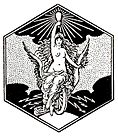Ludwig Sütterlin (graphic designer)
Ludwig Sütterlin (born July 23, 1865 in Lahr in the Black Forest ; † November 20, 1917 in Berlin ) was a graphic artist , book designer, craftsman, type designer and teacher and the developer of the Sütterlin font .
Life
At the age of 23, Sütterlin moved from his hometown of Lahr in the Black Forest to Berlin. At the Berlin Museum of Decorative Arts he was a student of the graphic artist Emil Döpler , who had designed the then new German Imperial Eagle , and of the history painter Max Friedrich Koch . Sütterlin created highly regarded designs for posters (including the "hammer poster" of the Berlin trade exhibition in 1896), glasses ("Sütterlin vases") and leatherwork. In 1902 he designed the magnificent volumes Marksteine aus der Weltliteratur in original fonts , which earned him additional attention. He taught at the educational establishment of the Royal Museum of Applied Arts in Berlin , which later became the United State Schools for Free and Applied Arts , where he also held courses in artistic writing, and he also gave specialist lessons for book printers at the craft school in Berlin. Sütterlin died in 1917, possibly of malnutrition.
- Examples of the work of Ludwig Sütterlin
The first trademark for AEG , 1894
The so-called hammer poster , 1896
The founding share of Siemens & Halske , 1897
Glass design for the Fritz Heckert glassworks , 1900–1910
Title page design on behalf of J. Baensch-Drugulin , 1902
Sütterlin's original writings for school
In 1911, on behalf of the Prussian Ministry of Culture , Ludwig Sütterlin developed a simplified German and a Latin original font , which was influenced by Art Nouveau and no longer contained any shading, from the German Kurrentschrift (also "Eckenschrift", in the version from 1911), which had been in use until then the age of writing with goose feathers were typical) and made learning in schools much easier. So Sütterlin designed squiggles, arches and spikes for better handling. The characteristic "swell" when writing with goose quills, with elegant, but difficult hair and shadow lines, had an unnatural hand position, changing writing pressure and thus required a lot of practice, which elementary school students often failed.
Instead, Sütterlin took up the ideas of the font reformer Rudolf von Larisch (1856–1934), whom he valued, and developed a child-friendly method for beginners: A leveling or redis pen was used as an elementary writing tool , which produced a uniform line width without changing pressure. All letters were vertical and were geometrically composed of straight lines and circles.
The document was presented to the Prussian minister of education and a committee of experts in 1914, found to be suitable by them and initially introduced in Prussia on a trial basis with a decree of July 8, 1915 , and finally declared binding for all of Prussia with a further decree of June 13, 1918 (Thuringia 1929, Hessen 1930, Baden and Danzig 1931). Sütterlin himself said of his writing: “Our new letters want to be nothing more than simple models for the beginnings of lessons, which make little demands on the child's ability to understand and represent. They want to be the basis on which the further development of flowing, beautiful and clear handwriting can take place over the course of the teaching years. ”From 1935, writing was on the curriculum and was used in schools until broken scripts were banned by the 1941 script decree used. After the German script was banned in schools in 1942, the Latin script was introduced as the starting script in a variant called German normal script . From 1953 this was replaced in West Germany by the Latin initial script (LA), which was developed by the Iserlohner Schreibkreis from the German normal script, which in turn went back to Sütterlin's Latin script.
literature
- Reinhold Zilch : The introduction of the Fraktur font by Ludwig Sütterlin and the Prussian Ministry of Culture (1910–1924). In: Haas, Stefan / Hengerer, Mark (ed.): In the shadow of power. Communication cultures in politics and administration 1600–1950. Campus, Frankfurt / M .; New York 2008, pp. 203-219.
- The search engine Google honored Ludwig Sütterlin in July 2018 with a doodle written in Sütterlin script
Web links
- Literature by and about Ludwig Sütterlin in the catalog of the German National Library
- Paul Kersten, Ludwig Sütterlin: The exact book cover . Verlag von Wilhelm Knapp, Halle ad Saale 1909. (In the digital offer of the University Library Weimar. [1] )
- Example of glass design by Sütterlin: Kunstglas Industrie 1866-1923 , pp. 17–24
- Sütterling glasses at the international exhibition in Turin 1902: The 1st international exhibition for modern decorative art in Turin 1902 , p. 336
- Example of the security design by Sütterlin: A constantly updated overview of artistically designed historical securities and their originators. P. 275
- Friends of German Curriculum
- Ludwig Sütterlin ( Memento from September 28, 2007 in the Internet Archive ) in Die deutsche Schrift , issue 3/1999
Individual evidence
- ↑ Michael Holger: Ludwig Sütterlin. In: Private website about the Ortenau. Archived from the original on December 1, 2017 ; accessed on July 23, 2018 .
- ↑ a b Klaus-Dieter Stellmacher: Ludwig Sütterlin. In: Sütterlinstube. Retrieved July 23, 2018 .
- ↑ Jens Minor: Ludwig Sütterlin: A very special Google Doodle for the 153rd birthday of the inventor of the Sütterlin script . In: GoogleWatchBlog . July 22, 2018 ( googlewatchblog.de [accessed July 22, 2018]).
| personal data | |
|---|---|
| SURNAME | Sütterlin, Ludwig |
| BRIEF DESCRIPTION | German graphic artist, educator and creator of the Sütterlin fonts |
| DATE OF BIRTH | July 23, 1865 |
| PLACE OF BIRTH | Lahr in the Black Forest |
| DATE OF DEATH | November 20, 1917 |
| Place of death | Berlin |






